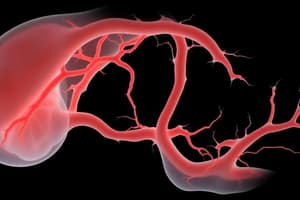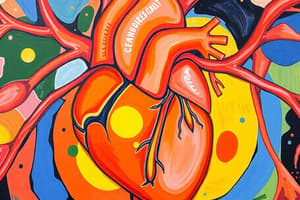Podcast
Questions and Answers
Which germ layer primarily gives rise to the heart's structures?
Which germ layer primarily gives rise to the heart's structures?
- Mesoderm (correct)
- Endoderm
- Neuroectoderm
- Ectoderm
Why is cardiovascular system one of the first to develop and function during embryogenesis?
Why is cardiovascular system one of the first to develop and function during embryogenesis?
- The developing embryo needs a way to transport nutrients, oxygen and remove waste very early on. (correct)
- It regulates the development of other organ systems.
- It is the simplest system to form.
- Nervous system development depends on it.
Around what day does the heart begin to beat during embryonic development?
Around what day does the heart begin to beat during embryonic development?
- Day 40
- Day 15
- Day 30
- Day 22 (correct)
What is the initial structure from which the heart develops?
What is the initial structure from which the heart develops?
What is the role of the endocardial cushions in cardiac development?
What is the role of the endocardial cushions in cardiac development?
What is the importance of the foramen ovale during fetal development?
What is the importance of the foramen ovale during fetal development?
The ostium secundum forms due to what cellular process?
The ostium secundum forms due to what cellular process?
What vessels does the truncus arteriosus eventually divide into?
What vessels does the truncus arteriosus eventually divide into?
How does blood flow through the heart change immediately after birth?
How does blood flow through the heart change immediately after birth?
Which change promotes the closure of the foramen ovale after birth?
Which change promotes the closure of the foramen ovale after birth?
What stimulates the ductus arteriosus to constrict after birth?
What stimulates the ductus arteriosus to constrict after birth?
When the umbilical cord is clamped, what happens to systemic vascular resistance?
When the umbilical cord is clamped, what happens to systemic vascular resistance?
What is the typical functional closure time for the ductus arteriosus in a newborn?
What is the typical functional closure time for the ductus arteriosus in a newborn?
What cardiac defect is associated with the heart looping to the left instead of to the right?
What cardiac defect is associated with the heart looping to the left instead of to the right?
What is Wharton's jelly, found in the umbilical cord, composed of?
What is Wharton's jelly, found in the umbilical cord, composed of?
Flashcards
Cardiovascular system development
Cardiovascular system development
The first major system to function during development, appearing in the 3rd week (18-20 days). Heart beat starts in 4th week (22-23 days).
Heart Tube Formation
Heart Tube Formation
The heart tube forms from fusing endocardial tubes.
Cardiac Looping
Cardiac Looping
A process where the heart tube bends and twists, establishing the future positions of the ventricles and atria. Begins around day 22.
Endocardial Cushions Role in Septation
Endocardial Cushions Role in Septation
Signup and view all the flashcards
Ostium Primum
Ostium Primum
Signup and view all the flashcards
Ostium Secundum
Ostium Secundum
Signup and view all the flashcards
Foramen Ovale
Foramen Ovale
Signup and view all the flashcards
Atrioventricular Septum Formation
Atrioventricular Septum Formation
Signup and view all the flashcards
Aorticopulmonary Septum Formation
Aorticopulmonary Septum Formation
Signup and view all the flashcards
Ventricular Septation
Ventricular Septation
Signup and view all the flashcards
Blood Flow Before Septation
Blood Flow Before Septation
Signup and view all the flashcards
Umbilical Cord
Umbilical Cord
Signup and view all the flashcards
Fetal Circulation Shunts
Fetal Circulation Shunts
Signup and view all the flashcards
First Breath
First Breath
Signup and view all the flashcards
Foramen Ovale Closure
Foramen Ovale Closure
Signup and view all the flashcards
Study Notes
- Pediatric & Adolescent Medicine II is covered in Module 1: Cardiovascular Development at UNM PA Program
Objectives
- Describe the normal embryological development of the cardiovascular system
- Describe the physiologic changes from prenatal to neonatal circulation
Normal Embryologic Development of the Heart
- Primarily derived from the mesoderm
- The first major system to function
- Appears in the 3rd week around 18-20 days
- Heartbeat initiates in the 4th week around 22-23 days
- Blood begins circulating in the 4th week
The Heart Tube
- The cardiogenic area, primitive blood vessels, and endocardial tubes are visible at 18 days
- At 20 days, ventral view images show fusing endocardial tubes within the pericardial cavity
- At 21 days, fusion into a primitive heart tube can be seen
Cardiac Looping
- At 22 days, the truncus arteriosus, bulbus cordis, primitive ventricle, and primitive atrium are all visible
- The heart tube starts to bend and loop
- By 23 days the heart is continuing to loop
- At 24 days, looping ends around 35 days
Septation
- At the end of the 4th week, the heart begins to septate
- Endocardial cushions start the separation of the heart into the right and left, upper and lower chambers
- The chambers become the atria and ventricles
- Mostly completed by the end of the
Atrial Septation
- The septum primum reduces blood flow from the right atrium to the left
- The opening between the right and left atria is called the ostium primum
- The septum continues to grow until the ostium primum is nearly closed and blood flow decreases
Atrial Septation
- Apoptosis happens in the septum primum, causing the ostium secundum
- The ostium secundum allows continued delivery of oxygenated blood to the left atrium
Atrial Septation
- The septum secundum nearly overlaps the ostium secundum, creating the foramen ovale
- The foramen ovale establishes a one-way passage for blood from the right atrium to the left
Atrioventricular Septum
- During the 4th week, the endocardial cushions grow to divide the heart into left and right atrioventricular canals
- Tissue along the periphery of each AV canal thins to form AV valves
The Truncus
- In the 5th week, swellings appear in the truncus arteriosus
- The swellings migrate and rotate, forming the aorticopulmonary septum
- The septum divides the truncus into the aorta and the pulmonary channels which become the aorta and pulmonary trunk
The Truncus
- Other truncal swellings thin to form the semilunar valves
Ventricle Septation
- Around the 4th week, and the muscular ventricle walls start expanding
- Medial ventricle walls grow toward each other, merging to form the interventricular septum
- The superior membranous portion of the interventricular septum from the endocardial cushions completes the closure of the interventricular foramen
Blood Flow Through Heart
- Before septation of the heart and truncus arteriosus, all blood from the left and right atria goes from the primitive (future left) ventricle through the foramen to the bulbous cordis (future right ventricle) and to the truncus arteriosus to developing pulmonary arteries and aorta
- Also called "double inlet left ventricle and double outlet right ventricle"
Blood Flow Through Heart
- After fusion of endocardial cushions and septation of the truncus arteriosus into primitive pulmonary artery and aorta, the heart begins functioning as 4 chambered heart
- Looping completes, valves and their respective atria migrate and develop, great arteries separate and develop
- Final form is achieved at ~8 weeks and continues to grow in size
Blood Flow, Umbilical Arteries & Vein
- The umbilical cord if formed by week 5
- Protects the vessels that travel between the fetus and the placenta
- The umbilical cord normally contains two umbilical arteries and one umbilical vein
- Vessels are embedded within a loose, proteoglycan-rich matrix called Wharton's jelly
Fetal Blood Circulatory System
- The placenta has 2 separate circulatory systems: maternal-placental circulation, and fetal-placental circulation
- All nutrition and O2 comes from mother to fetus through the umbilical vein
- Nutrient-depleted blood, waste products, and carbon dioxide are transferred from fetus back to mother through the umbilical arteries
Fetal Blood Circulatory System
- Fetal circulation has 3 shunts that bypass the liver and lungs
- The Foramen Ovale (lungs), moves blood from the R atrium to the L atrium, bypassing the R ventricle
- The Ductus arteriosus (lungs) moves blood from the pulmonary artery to the aorta
- The Ductus venosus (liver) moves blood from the umbilical vein to the IVC and R atrium
Circulation After Birth
- After birth, the umbilical cord (blood & O2 supply) is clamped, then cut
- The lungs must oxygenate the blood
- The first breath provides O2 in the lungs and the action of breathing
- Clamping the cord improves blood flow to the lungs
Circulation After Birth
- Increased systemic vascular resistance increases the pressure in the L atrium
- L atrial pressure becomes higher than the R atrial pressure, pressing against the septum primum, closing the foramen ovale
- The smooth muscle in the ductus arteriosus constricts in the presence of high O2 levels
- Completes the separation of the heart into two pumps
Newborn Circulatory Milestones
- The foramen ovale closes and can no longer act as a shunt between the two atria of the heart Functionally closes immediately after birth; anatomically closes within 12 month
- The ductus arteriosus closes and no longer provides communication between the pulmonary artery and aorta Functionally closes 12-24hrs; anatomically closes in 2-3 weeks
- The ductus venosus constricts so that all blood entering the liver passes through the hepatic sinusoids Functionally closes immediately after birth; anatomically closes after 1-3 month (ligamentum venosum)
- Occlusion of the placental circulation causes an immediate drop in blood pressure
- Systolic range is 46 to 94mmHg, diastolic range 24 to 57mmHg
Abnormalities of Looping
- Associated with isomeric cardiac lesions
- Dextrocardia; heart loops to left instead of to right
- Situs solitus, situs inversus, or situs ambiguus
Dextrocardia
- Situs solitus: ~90% have significant cardiac issues
- May have aorta connecting to right ventricle, usually with Ventricular Septal Defect (VSD) and Endocardial Cushion Defects, and Pulmonary Valve Stenosis
- Situs inversus: ~5-10% have significant cardiac issues
- Situs ambiguus: severe disorganization of organs with high mortality rate
Endocardial Cushion/Septal Defects
- aka atrioventricular (AV) canal or septal defects
- Atrial septal defects
- Ventricular septal defects
- Defects of the great vessels can include Tetralogy of Fallot and Transposition of the Great Vessels
Circulatory System Defects
- a small % of umbilical cords contain only one artery
- Associated with chromosomal abnormalities and congenital malformations like neural tube and cardiac defects
- Arterial system defects include; Patent ductus arteriosus, Coarctation of the aorta, Double aortic arch (vascular ring)
- Venous system defects include; Double inferior or superior vena cava, and Absence of the inferior or superior vena cava, and Patent Foramen Ovale (PFO)
Studying That Suits You
Use AI to generate personalized quizzes and flashcards to suit your learning preferences.




